“Baby” washing machine: operating principle, pros and cons + terms of use
Along with modern automatic washing technology, there are activator-type devices. These are compact, simple units without technological sophistication and devices. The most popular representatives are “baby” washing machines and their analogues.
Mini-erasers in comparison with full-featured brothers have both pros and cons. The appropriateness of using a portable unit depends on its operating conditions.
In this article, we will consider the popular models of "babies", we will analyze their design features and the principle of operation. We will also talk about the proper operation of this type of washer and the safety precautions for their use.
The content of the article:
Device and principle of operation
"Baby" is a small-sized washing machine of the activator type. This is not only the name of a specific model, but also the designation of all devices of small sizes, endowed with a minimum set of options, regardless of the manufacturer's company and the production series.
The device of any "baby" is quite simple.
The main structural units of the equipment:
- Plastic laundry tub. Most of the modifications are designed for a load of 1-4 kg, the maximum capacity of individual washing machines is 6 kg.
- Activator. A rotating disk with blades located on the bottom or side wall of the machine body. The element is responsible for mixing the laundry, an additional purpose is to ensure the strength of the plastic tank.
- Electrical engine. The motor drives the heart of the "baby" - the activator.
- Capacitor. The module smooths out differences in mains voltage and prevents the motor failure.
- Control module. Each compact washer has a built-in time relay and a control knob on the body.The mechanism allows you to set the washing time based on the contamination of things and the type of fabric.
The basic equipment includes: a removable cover, a drain hose and a stand.

The principle of the "baby" is simple. Dirty laundry is put in the tank, powder is poured and water is poured. After the unit is connected to the network, the operating time is set.
The electric motor provokes the rotation of the activator blades, and the laundry begins to mix intensively.
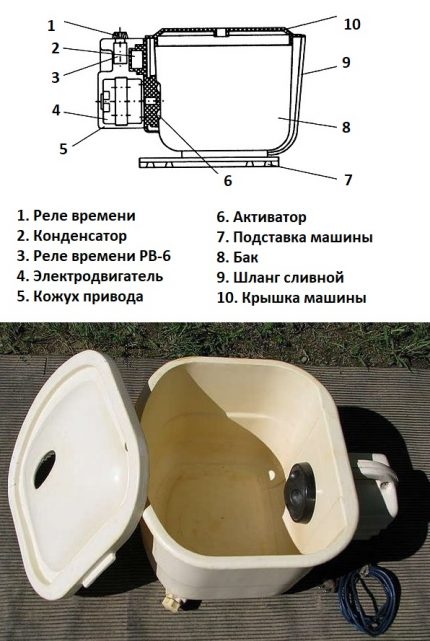
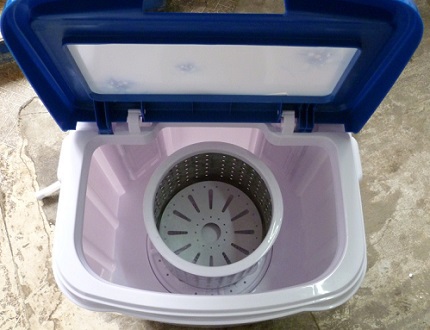
At the end of the cycle, dirty water is drained through a hose. If desired, the machine can also be used to rinse things. The cycle is repeated by analogy with the previous one, but this time a shorter interval is selected, the detergent is not used.
In more detail, the principle of operation of the activator type washer we examined in another our article.
Advantages and disadvantages of the unit
Simple design, minimal set of functions explain the low cost of portable equipment.
However, in addition to affordable prices, mini-cars have several advantages compared to more advanced units.
Strengths of the compact assistant
Arguments in favor of the "baby":
- Mobility. On average, the weight of the device is about 8-10 kg, and the dimensions allow you to transport the washer in the trunk of a passenger car.
- Cost-effectiveness. Over the entire washing cycle consumes a little electricity. Some models of the latest generation correspond to the most economical energy classes A, A +, A ++.
- Washing speed. Unlike full-featured washers, the “baby” copes with work in 10-15 minutes. Rinse in the car for another 5 minutes.
- Reliability. There are no complex mechanisms in the design, so there’s nothing much to break. Even in the event of failure of a single element, repairs will cost several times less than restoring a full cycle washing technique.
- Versatility. The appliance is suitable for all types of machine washable fabrics. The only remark: it is advisable to put particularly delicate things in a special bag.
The mini-machine is autonomous - it does not depend on a centralized water supply and sewage system. This turns out to be a decisive factor when choosing a "baby" for giving.
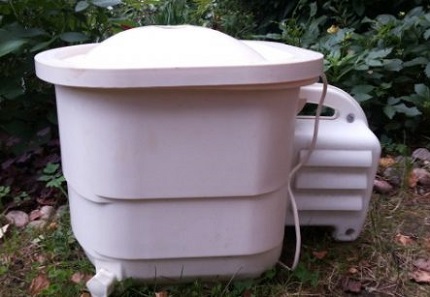
Compactness is a definite plus in cramped conditions. The baby can be stored in the pantry, under the sink or on the balcony.
If you have centralized water supply, and there is very little space in the bathroom, then you can install an automatic type mini-machine under the sink. TOP of the best washers under the sink we reviewed in following material.
The disadvantages of the miniature model
Based on user reviews, there are several obvious disadvantages of mini-washers:
- Low productivity. In one cycle, the machine is capable of washing up to 2-3 kg of laundry. With small and heavy things, for example, a set of bedding, curtains, a plaid or outerwear, the baby will not cope. They will have to be washed by hand.
- Noisy work. Some refuse to activate the technology because of the high hum. Unlike a fully automated washing machine, the mini-unit will not work in the evening or at night.
- Increased Safety Requirements. Water is an excellent conductor of current.Therefore, all manipulations with the linen must be performed after disconnecting the device from the network.
In terms of ease of use and practicality, the "little ones" are significantly inferior to their followers - automatic drum machines. Mini-units are not able to adjust the washing mode for a certain type of clothing or type of pollution.
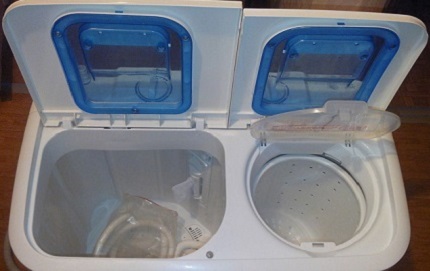
If you need a more functional version of the washing machine, where various washing modes are provided (and in some models, steaming and drying), we recommend that you familiarize yourself with the best automatic washers.
The best compact washing machines
Most units for express washing are produced by domestic manufacturers. Cars are located in approximately the same price segment, the main differences between the models: the maximum allowable load weight and the presence of secondary options.
Model # 1 - Baby Agate with reverse
A portable semi-automatic machine with top loading and an activator located at the bottom of the tank. The model is the prototype of the classic Baby washing machine, the main advantage is the reverse rotation of the disk with blades.
The model of the Ukrainian assembly weighs 7 kg, is equipped with a work timer (1-15 minutes) and has a power of 370 watts.
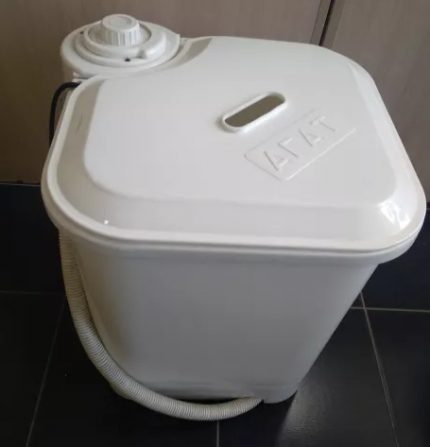
Estimated cost - 50 at. e. Users note the high efficiency of the machine and the good quality of washing.
Model # 2 - activating semiautomatic device Fairy SM-2
The popular, time-tested model of the mini-unit Fairy SM-2 has a simple, intuitive control and a reliable engine. The feedback from many users indicates the long-term, uninterrupted work of the assistant.
The washing machine weighs only 14 kg, its dimensions are standard for models of this plan - 45 * 44 * 47 cm. The unit tank is designed to wash 2 kg of linen, which is enough for periodic use in the conditions of a country house.
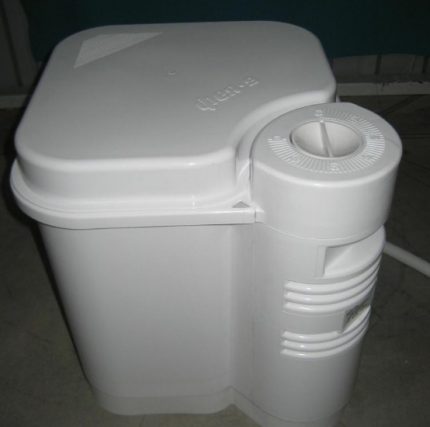
The tests showed that the activator device provides a more gentle cleaning mode in comparison with the automatic machine.
To improve the quality of washing, some users practice pre-soaking the laundry directly in the “baby” tank.
Among the shortcomings can be noted the vibration of the housing in the operating mode and cracking of the drain hose over time. The average price for a model is 50-55 y. e.
Model # 3 - Fairy-2P heated washer
Technically advanced version of the previous model - Fairy-2P. A distinctive feature is the presence of a heating element for heating water. The heating element maintains an optimum temperature throughout the entire washing process.
Extended and minor functionality:
- a half load mode is provided;
- the ability to set the temperature;
- safety complex: control of water level and foam.
The manufacturer has strengthened the design itself. The body is made of ordinary plastic, and the tank is made of composite polymer.
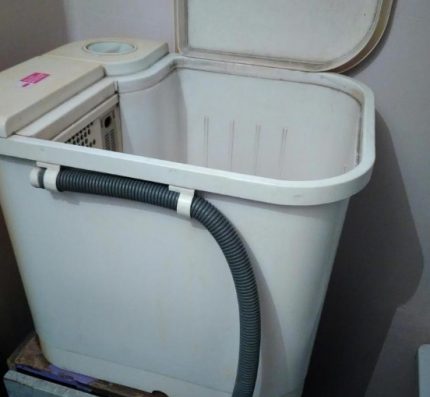
The manufacturer provides a two-year warranty, the estimated market value of Fairies-2P - 70 cu
Model # 4 - budget machine Princess SM-1
The Princess SM-1 washer is interesting for its functionality along with miniature dimensions. The unit is able to operate in four modes - the selection is made through a switch. A reverse-type activator is integrated on board.
The case is made of composite plastic, the weight of the mini-washer is only 5 kg, and the carrying capacity is 1 kg. IPX4 waterproof index.
Users respond positively to the performance and quality of the wash. Along with all the pluses, Princess SM-1 has a competitive cost of about 60 y. e.
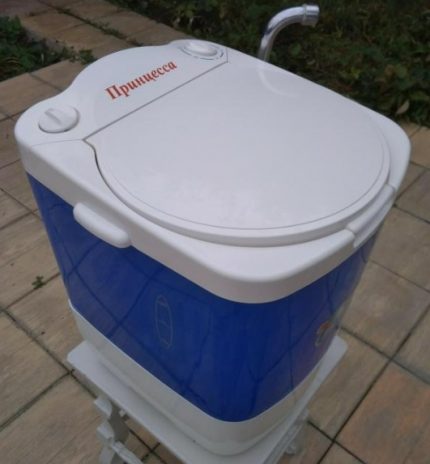
An additional compliment to the model is an attractive design, white and blue color.
Model # 5 - Baby ST 22-30-07 Spin
Some models of semi-automatic washers are equipped with a centrifuge. After washing, the laundry is removed from the tank, the water is drained and a special nozzle is installed inside the container. The washed items are placed back and the spin mode is set.
One of the representatives of this kind of compact spinning washers is ST 22-30-07. The machine is characterized by a high class of energy consumption.
Its capacity is up to 3 kg of laundry in one wash cycle. At the same time, there is a centrifuge inside the tank, which allows spinning, corresponding to class E.

The dimensions of the washing machine are 39 * 37 * 55 cm, it is possible to reload the laundry, the operating time in the spin mode is 3 minutes.
Other representatives of the "babies" with a centrifuge, which have gained popularity among users:
- VilGrand V105 - 5 kg, spin - 300 rpm;
- Mir MWM 228 - 2.5 kg, nozzle rotation speed - up to 300 rpm;
- Vimar VWM 61 - 6 kg, centrifuge speed - 300 rpm.
Almost all machines of the activator type provide low spin quality corresponding to class E. That is, linen after processing in a centrifuge loses up to 10-30% moisture.
Step-by-step instruction
The order of use of "babies" of most modifications is identical. Washing will not cause any difficulties if you adhere to the basic rules for the placement and connection of the washer. The main thing is to comply with safety standards.
Site selection and preparation
First of all, you should decide on the optimal arrangement of the machine.
Manufacturers of equipment are advised to take into account a number of nuances of the installation:
- The washing machine should not be in a cold room. Temperature extremes are extremely undesirable for the engine. If the unit was only brought from the street, then the connection must be done after 3-4 hours.
- Unimpeded access to the water intake and outlet must be ensured.. The minimum distance to the walls is 5 cm. This gap will help to avoid increased noise from vibration of equipment.
- For the convenience of draining the machine can be put on a wooden grill above the bath. It is advisable to put a rubber mat under the bottom.
- The base under the appliance must be level. and durable - warps are unacceptable.
Particular attention to connecting equipment - socket for washing machine must be grounded.

Washing sequence
Next, you need to sort the laundry according to the type and color of the fabric. In order not to spoil bright things, they must be washed separately from colored ones.
Subsequent work procedure:
- Expand the drain hose. edge up and lock in that position.
- Put laundry in the tankobserving the maximum allowable load weight.
- Add detergent to the container. It is better to give preference to preparations with a small formation of foam - this will increase the washing efficiency.
- Fill the tank with water to the mark indicated on the inside of the case.
- Connect the unit to the network, set the timer and start the "baby" in the work.
After the time has passed, the machine will automatically turn off. If necessary, the cycle can be repeated.
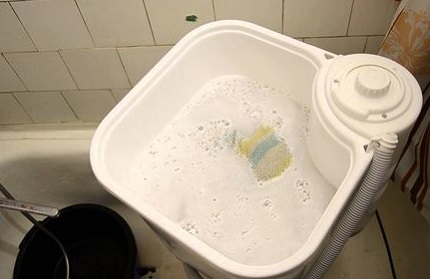
Before rinsing, clean and fill the container with water - the temperature of the liquid is about 30-40 ° C. Load the linen, set the timer for 2-3 minutes and turn on the machine. After washing and emptying the tank, the container and lid must be wiped dry with a cloth.
Safety Basics
Compliance with the rules of connection and operation will prevent emergency situations, as well as extend the term of use of the machine.
Basic requirements for the maintenance and care of the mini-washer:
- Do not leave a working device without supervision.
- It is strictly forbidden to touch the plug with wet hands.
- Taboo is installed to heat the water in the tank with an electric boiler.
- The machine must not be installed on the ground, nor can it be washed on a metal floor.
- It is forbidden to carry the unit connected to the network or filled with water, and also to operate equipment with signs of electrical defects.
The machine must be installed away from flammable products. Do not use solvents for washing.
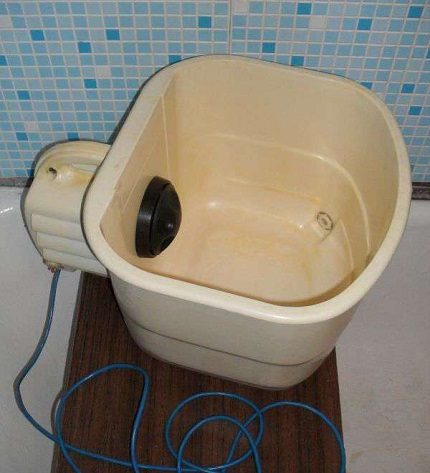
Conclusions and useful video on the topic
Recommendations for choosing washing machines:
"Baby" is an indispensable assistant in situations where there is no access to the water supply. Models with a reversible activator are washed better, and the presence of a centrifuge somewhat facilitates and accelerates the process.
The choice of tank volume depends on the number of users - for a family of three people, a 3-4 kg machine is suitable.
Choose a mini-washer for the cottage and want to ask other users for advice? Ask your questions in the comments section - our experts and other site visitors who have experience using the "baby" will try to help you.
A miniature washer - your assistant in the country? Share your opinion on ease of use and quality of washing, add a photo of your mini-machine.

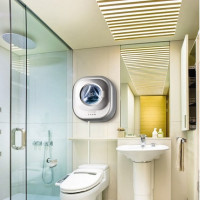 Wall-mounted washing machine: pros and cons of a hinged solution + rating of the best models
Wall-mounted washing machine: pros and cons of a hinged solution + rating of the best models 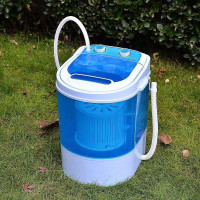 Activator-type washing machine: technical specifications and selection rules
Activator-type washing machine: technical specifications and selection rules 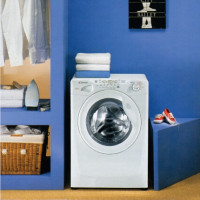 Which company has the best washing machine: how to choose + brand and model rating
Which company has the best washing machine: how to choose + brand and model rating 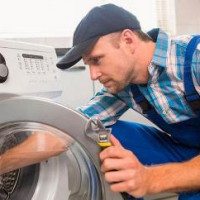 The washing machine does not wring out or makes noise during an extraction: analysis of the causes of breakdown and repair instructions
The washing machine does not wring out or makes noise during an extraction: analysis of the causes of breakdown and repair instructions  Inverter washing machine: how is it different from the usual + TOP-15 of the best models
Inverter washing machine: how is it different from the usual + TOP-15 of the best models 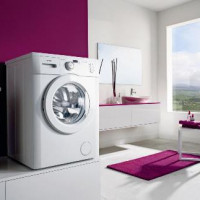 Why the washing machine does not turn on: causes of failure + repair instructions
Why the washing machine does not turn on: causes of failure + repair instructions  How much does it cost to connect gas to a private house: the price of organizing gas supply
How much does it cost to connect gas to a private house: the price of organizing gas supply  The best washing machines with dryer: model rating and customer tips
The best washing machines with dryer: model rating and customer tips  What is the color temperature of light and the nuances of choosing the temperature of the lamps to suit your needs
What is the color temperature of light and the nuances of choosing the temperature of the lamps to suit your needs  Replacement of a geyser in an apartment: replacement paperwork + basic norms and requirements
Replacement of a geyser in an apartment: replacement paperwork + basic norms and requirements
The first washing machine in the house was just the same “Baby”. Of course, she washed quickly, and did not take up much space in the bathroom, and she could do any kind of fabric. But the noise from her was “still that”. And the advantages of “Baby” regarding compactness along with the speed of washing clothes turned into disadvantages. There were many things, and the tank volume is negligible. Such cars are suitable for picky people.
Mom bought the washing machine “Baby” thirty years ago to wash a huge amount of dirty diapers. She served for a long time until either a button or another small part got into the activator, which stopped the washing machine forever. Dad dismantled the car, but could not fix it due to damage to its parts. Although it was possible to wash a small amount of laundry, mobility, economy and speed of washing were a priority then.
Baby served us faithfully until the purchase of a stationary good washing machine. We installed it on a stand in the bathroom, and brought the hose into the washstand and thus washed our things.Then she moved to the cottage, where we also washed things, only now the hose was not in the washstand, and the water just poured into the garden, and then went into the soil. The washing quality is normal.
I can’t say anything particularly good about her. Constant physical activity - bring, pour water, etc., after washing, it is wrapped in a spiral. There are a lot of minuses.
Here, I completely agree. I do not recommend this washing machine to modern housewives who are used to washing in normal washers. At one time they were perceived normally, I had one too, but when I had to wash it in a similar machine at the dacha now, I remembered all its disadvantages and was horrified. Can not be compared with modern ones. Wash a little easier than manually, but only a little.
In the "baby", as correctly noted above, it is best to wash the diapers using soap, not powder (as pediatricians advise), as well as hosiery. In addition, the cost of such a washing machine in the store is 1500-3000 rubles. In comparison with the machine, the difference is significant. It is not always possible to purchase a similar one immediately after a machine breakdown. Another “Baby”, in my opinion, is very relevant for use in dormitories.